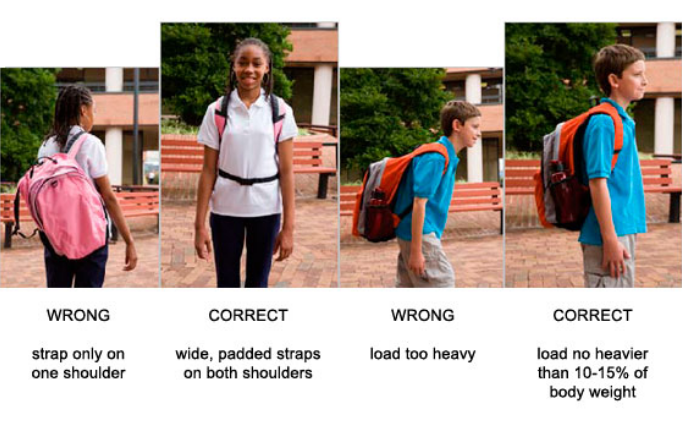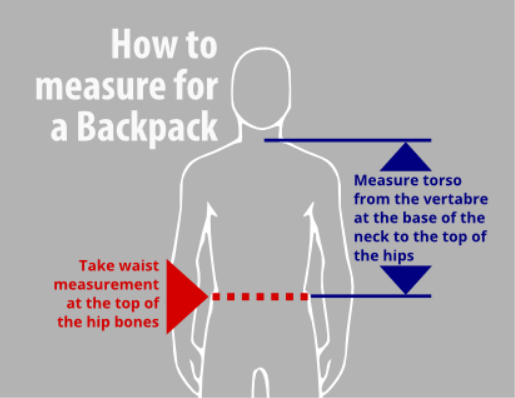It’s that time of year again! In just a short few weeks, our kids are heading back to school, with new classes, teachers, and challenges. Parents are making sure their children have all the school supplies like pens, pencils, notebooks, folders, lunch boxes, etc. that they’ll need for a successful school year. Have you ever thought about how heavy that backpack can get?
One of the things I have noticed with my own children is that they no longer use lockers. They have been assigned to them, they just don’t use them. Apparently, it’s just not as cool as it was back in the day. Now they don’t have all the big and heavy books that we had, but they have a computer, notebooks, writing utensils, and whatever else they think they need to carry with them every day.
If this is something you have observed with your own children a very important thing you should consider is how you can support their back so they can do their best in the new school year. A healthy, well-adjusted spine helps students focus in the classroom, increases brain function, boosts their immunity, and fights back against back pain caused by heavy backpacks, and back to school chiropractic care ensures that you have all these details and more!
How do I choose a good backpack?
Back pain isn’t just reserved for adults anymore. Chiropractors are seeing more and more children whose heavy backpacks are causing them poor back health and pain. Fortunately, some simple steps can help prevent these problems. Here are a few tips to keep in mind when you’re choosing a new backpack for the school year.
Kids will naturally gravitate to the color and style that they like but be sure the backpack they use is the right size. If it’s too small they’ll be more likely to sling it over one shoulder, causing an imbalance in the way their body carries the weight. This can stress some muscles and weaken others. If the pack is too big then they’ll be more likely to fill it up, making it heavier. Make sure the straps fit comfortably on both shoulders and tighten them enough, so they hold the backpack snugly against the body.
I know it’s not super cool to wear both straps of a backpack but encourage this as well. When worn on only one shoulder it will not only cause pain, but muscles to become either over engaged or weaker on one side.
Here are some quick tips to make sure that your child’s backpack is fitting properly:
- Carry no more than 10-15% of their body weight
- Wear the backpack so the weight falls high and evenly on the shoulders
- Keep the backpack snug to the body
- Be sure to choose a backpack with wide and padded shoulder straps which distribute weight more evenly
- Pack the heaviest items closest to the body and make use of the internal and external compartments to distribute the weight more evenly
- Always use both shoulder straps
- Choose a backpack with waist and chest straps and encourage their use
- A backpack should never be wider or longer than the torso or hang more than 4 inches below the waistline
- Consider a wheeled pack for heavier loads
As I mentioned above, I realize lockers are no longer “a thing”, but promote their use much as possible. Last year I really encouraged my daughter to use her locker, but with the short times between classes, she said she simply doesn’t have time to get there and back to her classes on time. We came up with a plan that she and her two friends would share ONE locker—the one closest to all their classes. This seemed to really help with the weight of her backpack as it was getting completely out of control!
The more books and supplies that can be stored instead of carried the better it is for your child’s back. Even one or two books or folders can really make a HUGE difference! As mentioned above, for proper backpack health, kids shouldn’t carry more than 10 – 15% of their body weight.
There are so many things to think about when your child begins another school year, but taking action to support your child’s spinal health will have benefits throughout the school year and beyond. Choosing a backpack that doesn’t strain their back can prevent pain that is distracting and undermines their learning.
Why would kids go to a chiropractor?
One of the first things you will notice when a backpack is not fitting properly is a forward, stooping posture and the headway forward over the shoulders or what is called forward head posture. Due to the rise in computer and smartphone use, this has become a problem even without the use of a heavy and poor-fitting backpack!
However, good posture is not simply a way to look more alert, confident (although this IS an issue and will be mentioned later), and “taller” for those out there that are vertically challenged but having poor posture can actually be detrimental to your health; especially as we age.
Obviously, most parents are unaware of how posture and health are related, so here are some health issues that are directly linked to poor posture over time:
- Chronic and acute pain in the back, neck, and shoulders
- Headaches
- Knee, hip, and back injuries
- Respiration problems
- Stiffness
- Fatigue
- Muscle atrophy and weakness
- Digestive problems
- Sciatica
- Formation of varicose veins or “spider” veins
- Impingement and nerve compression
- Carpal tunnel syndrome
How many of these issues have you already seen in your child? It goes without saying, that we are seeing these issues younger and younger these days and much of it has to do with the fact that we rely on technology so much in our everyday lives that we have become more sedentary than ever before.
The aches and pains that were once only common in older adults are starting to manifest as young as 4 years old! Migraines and headaches are now found in 3% of children of preschool children, 4% to 11% of elementary school-aged children, and 8% to 15% of high school-aged children according to the Cleveland Clinic!
Digestive Distress
How many teens and young adults do you know that suffer from these ailments? Yup! Not just for grandma and grandpa anymore—these issues are becoming serious issues at a younger and younger age.
- Constipation
- IBS
- Acid reflux
- Hernias
- Incontinence
These issues are caused by compression of the internal organs and of the abdomen. Correct posture permits these organs to maintain their natural position. When the upper body is rounded or in a slouched position, the rib cage and diaphragm muscles are unable to expand properly. Slouching postures can also lead to nerve impingements, lessening the ability of nerves to relay signals between our brain and body, leading to a less than optimal function of all the organs in the abdomen—which are many! This presentation is further exacerbated by the chronic use of a too heavy or ill-fitted backpack.
According to Meghan Markowski, a physical therapist at Harvard-affiliated Brigham and Women’s Hospital, “Researchers are also looking into whether posture affects mood, sleep, fatigue, and jaw alignment,”. So, let’s take a look at these issues. Raise your hand if you would like your child to be in a better mood and not fight you tooth and nail to get up in the morning!
Yeah, I thought so!
Body Language, Negative Emotions, and Poor Sleep
We all know that first impressions count and posture says a lot about personality. When children and young adults exhibit good posture, like holding their head up, and standing tall with an open chest it exudes confidence even though they may not feel that way inside. A slouched and lazy posture indicates disinterested body language which can negatively affect a variety of things, again, whether or not they are feeling poorly or not. Poor posture can inadvertently give off a number of negative cues such as:
- lack of confidence
- laziness/lack of motivation
- depression
- lack of personal care
A recent study was published in Health Psychology, where researchers monitored the effects of slumped or straightened posture on a group of 74 people. Each of the study participants were strapped into their assigned posture, either slumped or straightened, and then asked to perform a series of tasks. Their blood pressure and heart rate were constantly measured throughout. The results showed the following:
“Upright participants reported higher self-esteem, more arousal, better mood, and lower fear, compared to slumped participants. Linguistic analysis showed slumped participants used more negative emotion words, first-person singular pronouns, affective process words, sadness words, and fewer positive emotion words and total words during the speech. Upright participants had higher pulse pressure during and after the stressor.”
This is the posture we continually see while carrying a too-heavy backpack!
How to get your child to finally sit up straight—not bad advice for parents either…just saying’
- Corrective Chiropractic Care
- Properly fitted and weighted backpack
- Exercises
- Cervical Traction/Spinal Molding Exercises
- Better Computer and Cell Phone Ergonomics
What is corrective chiropractic care?
Corrective chiropractic care primarily focuses on the structure and function of your spine. Only 10% of the nerves in your body can sense pain. The other 90% of the nerves control the function of everything in your body. If you have a misalignment in your spine that is causing pain or a postural issue, it is likely that you have had a long-standing problem that has been affecting your function as well. In addition to the proper motion and position of the individual spinal bones, corrective chiropractic care focuses on the proper curvature of the spine. When looking at the spine from the side, there should be three distinct curves; forward in the neck, backward in the mid back, and forward in the low back. If there is deviation of these curves from normal, it can create abnormal tension on the brainstem and spinal cord, thereby creating dysfunction of the nervous system, resulting in neck or back pain, headaches, migraines, and significant postural abnormalities that can cause many other symptoms that disrupt nerve signals to different organs within your body and affecting your overall health as mentioned above.
Analyzing the structure and function of your spine requires specific X-rays to view the curvature of the spine and the function of each bone in relation to the ones above and below. This is especially important in the upper cervical spine at the skull, atlas (C1), and the axis (C2). This region is where the postural muscles get all of their information on how to function properly. HealthWorks utilizes a very gentle and specific technique that focuses on this region which once it’s aligned properly, can provide significant and instant changes in posture!
Our F3 exam (form, function, and findings) will give the information necessary to determine the proper treatment plan to provide the most specific correction possible, rather than merely chasing symptoms.
Traditional chiropractic care focuses just on acute symptoms, which is initially very important. However, our approach will not only focus on the acute issues, but also on the cause of poor posture and the subsequent health issues that could or already are manifesting in your teen or young adult before it
Having a properly aligned spine helps everyone function at their best, and children are no exception. Subluxations not only cause discomfort but also impede neural signals throughout the body, which can cause a cascade of dysfunction. If your child is suffering from back pain, they would definitely benefit from a spinal adjustment. Children respond quickly to chiropractic care. When they are properly aligned it not only helps them in the classroom but also to grow to become the healthiest adults they can be.
Whether you are a student, teacher, or parent, we are here to help you achieve your best, most vibrant health. As the school year begins, take this back-to-school season as an opportunity for chiropractic care for your spine so you’re ready to tackle the challenges ahead.
If you have any questions, bring the backpack and your child to HealthWorks to see if they are meeting proper backpack-wearing techniques. We are more than happy to help and give you and your personalized guidance for their particular needs!
Our promise to you
HealthWorks is dedicated to a comprehensive and specific approach to taking care of spinal and nervous system needs. Let us help you find out how taking care of the most important system in the body will create optimal health that will last a lifetime!
If we find we’re not the best to help with your condition, we promise to refer you to someone who is.
References:
- Cleves C, Rothner AD. Headache in Children and Adolescents: Evaluation and Diagnosis, including Migraine and its Subtypes. Chapter 6. In: Tepper SJ, Tepper DE, eds. The Cleveland Clinic Manual of Headache Therapy. New York: Springer 2011:81-92.
- https://www.health.harvard.edu/staying-healthy/3-surprising-risks-of-poor-posture
- Nair S, Sagar M, Sollers J 3rd, Consedine N, Broadbent E. Do slumped and upright postures affect stress responses? A randomized trial. Health Psychol. 2015 Jun;34(6):632-41. doi: 10.1037/hea0000146. Epub 2014 Sep 15. PMID: 25222091.



